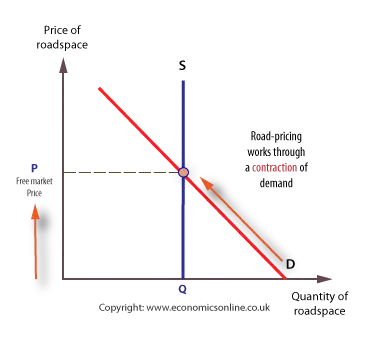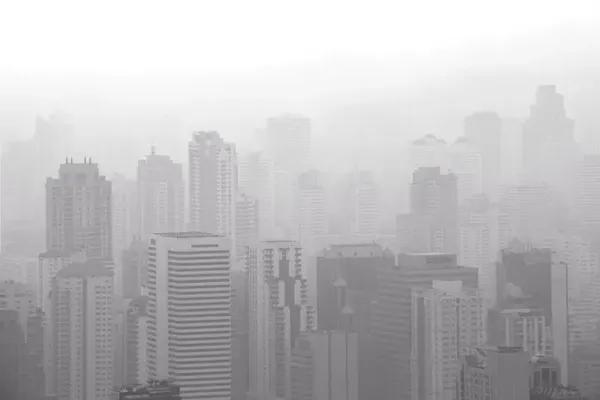
Road Congestion
Road Congestion
There are a several reasons why roads have become increasingly congested, including the following.
- The real cost of driving has fallen because motor cars, and even petrol, are relatively cheaper than they used to be in real terms – that is when taking inflation into account.
- Public transport is seen by many as an inferior good, which means that as incomes rise, people switch away from inferior goods.
- Roads are a common property resource, and as such, people are free to use them with little restriction.
- The fixed cost of buying and owning a car, including the price, motor insurance, car tax, and depreciation, encourage drivers to use their cars as often as possible.
- Information failure also has an influence on the amount of driving that happens. No single driver knows the full impact they have on others, and even if they know, they are unlikely to take it into account.
Road space as a scarce resource
Road-space is a scarce resource, which means that the more private individuals use road space the less is available for use by others.
By creating the concept of road-space, policy makers are viewing roads, which were previously considered a public good, as a private good which can be charged for. The application of new technologies, like GPRS, can be used to create systems for charging for the use of road-space.
Congestion creates external costs including;
- Extra travelling time.
- Increased business costs.
- Emergency services, such as ambulances, police-cars and fire engines, find it harder to function effectively.
- Increased pollution, such as air and noise.
- Increased probability of more accidents.
- More stress for drivers, cyclists, passengers and pedestrians.
The causes of congestion
It can be assumed that the demand for road-space will fall as the price rises, because of income and substitution effects of a higher price.

The standard MSC = MSB diagram, showing congestion as an external cost of consumption can also be used to illustrate the Net Welfare Loss of ‘too much’ driving.
Remedies for congestion
There are three basic remedies for road congestion, including increasing supply of road-space, reducing demand and increasing price.
Increase the supply of road space
Firstly, government can increase the supply of road space by building more roads.

However, with more roads, drivers are encouraged to drive and the demand for road space increases. Demand shifts to the right, and congestion still exits! In addition, there are large building costs and an opportunity cost! There is also a long time lag between planning and availability.
Reduce the demand for road-space
Demand for road-space can be reduced in two ways; by decreasing car ownership or by decreasing car usage.

Measures might include:
- Raising fuel taxes and car taxes.
- Increased driving license fees.
- Providing bus lanes, better public transport, and no-parking routes, such as the UK red route scheme.
- Operating park and ride schemes.
- Increasing parking charges.
- Raising the age limit for driving.
- Legislating on the number of passengers in cars.
However, set against these are:
- The costs of implementation.
- The UK’s strong preference for cars.
- If successful, there could be a loss of jobs in the car industry, and lost revenue to firms who rely on traffic flow.
Road pricing
Thirdly, the government could adopt a road pricing system by charging for the use of road-space. Road pricing has been used in Singapore, where electronic detectors are placed on bridges and drivers are charged for access to the road-space, that is, access to the road network.

The London Congestion Charge
In April 2003, the Mayor of London introduced a £5 per day congestion charge. In July 2005, this was raised to £8 per day.
Transport for London estimated that the impact on traffic flow was a reduction of 50,000 cars per day.
It also estimated that:
- Journey times are 15% faster
- Bus journeys are up by 15%
- Taxi journeys are up by 20%
- Cycle usage is up by 30%
Source, Transport for London, February 2004
Criticisms of the congestion charge
While appearing successful at reducing traffic, critics have argued that:
- It was very costly to introduce.
- Revenues from fines were much lower than expected.
- There were serious technical problems with the number plate recognition software.
- It is unfair on those low paid that have to drive into London to work, such as key workers, such as nurses, ambulance drivers, and the police.
- The charge is regressive in its impact, which means the poor pay proportionately more of their income on the charge than the rich.
- Many businesses have suffered as people stop shopping in London.
Despite the criticisms, there were plans to extend the charge zone, but in 2008, the Mayor of London decided to abolish the western extension of the charge zone. In addition, plans for a congestion zone in Manchester were shelved after local residents voted against it.
Congestion charging, perversity and moral hazard
One problem with schemes to alter people’s behaviour to achieve desired outcomes is that the reverse can happen, and people behave perversely.
For example:
- Speed cameras positioned at regular intervals on roads may encourage drivers to ‘speed up’ between cameras.
- Speed bumps on roads may encourage people to take longer trips to avoid them, hence increasing congestion and pollution.
- As the costs of driving in London (and other cities) have increased, the illegal dumping of cars has also increased.


